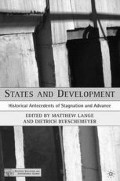Abstract
In the early twenty-first century, the hierarchy of advanced industrial nations remains quite similar to what it was at the end of the nineteenth century: the leading economy today, the United States, was the most productive industrial power then; the leading economy then, the United Kingdom, remains a powerful industrial economy today, its size roughly comparable to France and Italy; Germany is still the economic powerhouse of Central Europe, as it was then.A century ago, Japan’s industrial prowess was just beginning to gain notice, however, and it would not become a major industrial power until the 1930s. A century ago, Korea had just begun to industrialize, something hardly anyone noticed, but today it is a major, fully industrialized country with state-of -the-art technology in many fields. Japan and Korea are striking examples of industrial development precisely because the new entrants to advanced industrial status are so few—or so familiar in their long-run continuity In 1900, a sage might have predicted this outcome for Japan, but no one but a clairvoyant would have picked Korea. South Korea’s growth thus strikes observers as rapid, unusual, even miraculous. So how did it happen?
Access this chapter
Tax calculation will be finalised at checkout
Purchases are for personal use only
Preview
Unable to display preview. Download preview PDF.
References
Amsden,Alice. 1989. Asia’s Next Giant: South Korea and Late Industrialization. NewYork: Oxford.
Cumings, Bruce. 1997. Korea’s Place in the Sun:A Modern History. NewYork: Pantheon Books.
—. 1981. The Origins of the Korean War, vol. 1. Princeton: Princeton University Press.
—. 1999.“Webs With No Spiders, Spiders With No Webs: Reflections on the Developmental State.” In The Developmental State. Edited by M.Woo-Cumings. Ithaca: Cornell University Press, 61–92.
Eckert, Carter J. 1991. of fspring of Empire:The Koch’ang Kims and the Origins of Korean Capitalism. Seattle: University of Washington Press.
Gale, James Scarth. 1972. History of the Korean People. Seoul: Royal Asiatic Society.
Johnson, Chalmers. 1982. MITI and the Japanese Miracle:The Growth of Industrial Policy, 1925–1975. Stanford: Stanford University Press.
Kim Dae Jung. 1985. Mass Participatory Economy. Cambridge: Harvard East Asian Center.
Lautensach, Hermann. 1945. Korea: A Geography Based on the Author’s Travels and Literature.Trans. Katherine and Eckart Dege. Berlin: Springer-Verlag.
Lowell,Percival. 1888. Chosön:The Land of the Morning Calm. Boston:Ticknor and Company.
Palais, James. 1975. Politics and Policy in Traditional Korea. Cambridge: Harvard University Press.
Polanyi, Karl. 1957. The Great Transformation.NewYork: Beacon Press.
Tsurumi, E. Patricia. 1967.“Taiwan under Kodama Gentarö and Gotö Shimpei.”Papers on Japan, v. IV. Cambridge, MA: Harvard University, East Asian Research Center.
Wallerstein, Immanuel. 1992. Unthinking Social Science. NewYork: Basic Books.
Woo, Jung-en. 1991. Race to the Swift: State, Finance and Industrialization in Korea. New York: Columbia University Press.
Editor information
Editors and Affiliations
Copyright information
© 2005 Matthew Lange and Dietrich Rueschemeyer
About this chapter
Cite this chapter
Cumings, B. (2005). State Building in Korea: Continuity and Crisis. In: Lange, M., Rueschemeyer, D. (eds) States and Development. Political Evolution and Institutional Change. Palgrave Macmillan, New York. https://doi.org/10.1057/9781403982681_10
Download citation
DOI: https://doi.org/10.1057/9781403982681_10
Publisher Name: Palgrave Macmillan, New York
Print ISBN: 978-1-4039-6493-9
Online ISBN: 978-1-4039-8268-1
eBook Packages: Palgrave Political & Intern. Studies CollectionPolitical Science and International Studies (R0)

